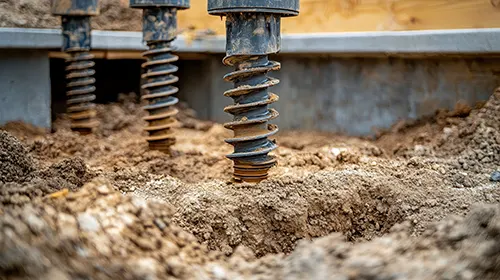
Some foundation contractors would have you believe that you need helical piers to lift a house to solve foundation crack problems….that spot fixing foundation cracks is just a Band-Aid. Adam, a civil engineer, explains what he thinks about these super high dollar repairs…and if they are really necessary.
Narrator: The topic of today's podcast: Are helical piers necessary to support my home? So, Adam, some foundation contractors would have you believe that you need helical piers to lift a house to solve foundation problems. That spot fixing foundation cracks is just a band aid. You're a civil engineer. What do you think about these super high dollar repairs? Are they really necessary?
Adam: There's a lot of information out there in the age of the internet, and a lot of misinformation naturally, as we live on a daily basis and find out via different news cycles. One of the biggest issues that we see in this industry is homeowners getting pressured to repair simple cracks in their concrete or block foundations by going straight to the maximum level of repair. That would involve structural reinforcement via helical piers.
So what are these? These are basically jacks or pistons that get driven down to either stable soil or bedrock, depending on which comes first. They go underneath the house and lift it. These are industry-accepted solutions, used on large commercial buildings all the way down to small homes, even decks. The intention is to stabilize a foundation when soil conditions can no longer properly support the weight of the home.
The most common situation where we see the need for this—and by common, we mean less than one in 500 homes—is in old neighborhoods where developers clear-cut a forest, buried the stumps in one lot, and then built on top. Over time, those buried stumps rot, and the lot starts to sink. That’s the classic case. Typically, homes built between 1970 and 1990 are where we see this problem. In those cases, the house can drop several inches, and you truly need to get under the house and lift it.
But that doesn’t mean every single foundation crack is the result of such a problem. Most cracks we see are simply the result of settling. Whether it’s a small amount or a large amount, settling is natural. No matter how well soil is compacted before a foundation is built—whether in 1940 or 2025—the ground will still settle slightly under the weight of the home. That’s why foundations almost always develop some cracks.
The footing helps spread the weight out, and builders may use gravel and compaction, but there’s always variability—weather, soil conditions, and unforeseen site issues. As the home settles, cracks can appear because of the foundation’s rigidity. That’s why, in New England for example, it’s rare to see a foundation with no cracks at all.
The real question we ask is: What does the crack look like? Is there deflection, where one side is pushed out or separated? How does the structure look overall? What about the roofline? And most importantly, how long has the crack been there? In most cases, settling happens very early in the construction process, and once the home adjusts, it stays stable at that level for good.
The bigger concern is when freeze-thaw cycles in winter make cracks worse over time. That’s when foundation repairs become necessary. Helical piers are only warranted when a crack has left the foundation totally unsupported and literally pulling away from the house. This is very rare, but repairs in such cases can cost $50,000 to $100,000 or more.
The good news is that most foundation cracks don’t require that level of repair. Epoxy or urethane injection is often enough. Reinforcing with rebar or structural carbon fiber can also stabilize the wall at a fraction of the cost, all with internationally accepted techniques.
Concrete is the most widely used man-made material on earth, and it’s extremely well studied. There are entire organizations dedicated to providing proper repair guidance. While helical piers do have a place, that place is not in repairing a typical foundation crack or minor settling.
So don’t let someone scare you into thinking your house will collapse unless you spend tens of thousands of dollars right away. Most issues are simple repairs that can be completed in a day—no home equity loan required. Be cautious, find a trusted resource (whether us or someone else), and make sure you’re doing the right repair for the right issue.
Most problems do not need to cost tens of thousands. In fact, they usually fall well below that, and the work should be warrantied—hopefully giving you peace of mind.
Narrator: Well, thanks, Adam, for explaining why high dollar helical piers are typically not necessary to solve foundation crack problems.
Narrator: If you have a basement water problem and think you need a professional, or, if you’d like more information on foundation crack repair and basement waterproofing topics, please visit A1FoundationCrackRepair.com or call Adam at (866) 929-3171. Or you can email Adam at info@a1foundationcrackrepair.com. Thanks for listening and keep that basement dry.

